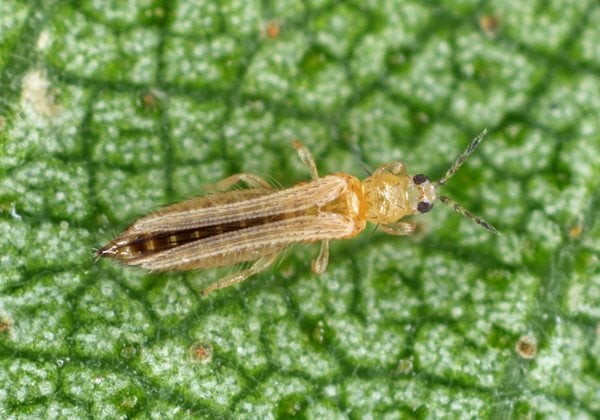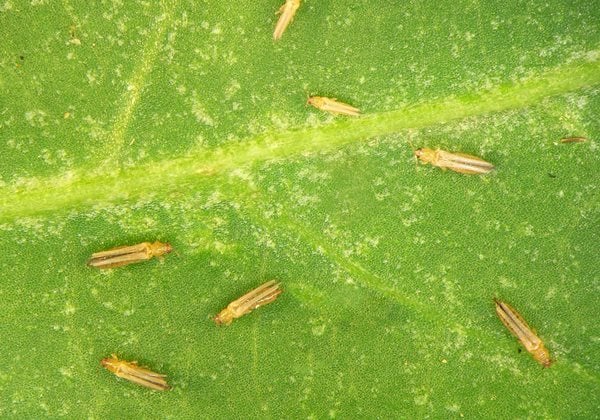How to Identify & Control Thrips
Get rid of these pests before they cause serious harm to your plants
Photo by: Tomasz Klejdysz / Shutterstock
Thrips are a common pest on both outdoor and indoor plants. They cause damage by feeding on plant sap, destroying plant tissues with their chewing mouthparts. These insects thrive in warm conditions, becoming a bigger problem outdoors during summer months.
Because they are tiny and multiply rapidly, thrips can go undetected until a serious infestation is already underway. Many of the symptoms of thrips are similar to other pests and even some diseases, so it’s crucial to know the source of the problem before treating affected plants.
Here’s how to get rid of thrips on your house or garden plants.
On this page: What Are Thrips? | Get Rid of Thrips | Prevent Thrips | Recognize the Presence of Thrips | Identify Damage | Plants Susceptible | Thrips on Houseplants | Life Cycle of Thrips
On this page:
- WHAT ARE THRIPS?
- HOW TO GET RID OF THRIPS ON PLANTS
- HOW TO PREVENT THRIPS
- RECOGNIZE THE PRESENCE OF THRIPS
- IDENTIFY THRIPS DAMAGE ON PLANTS
- PLANTS SUSCEPTIBLE TO THRIPS
- THRIPS ON HOUSEPLANTS
- LIFE CYCLE OF THRIPS
WHAT ARE THRIPS?
There are more than 6,000 species of thrips, many of which are harmful to plants. Many species prefer feeding on certain plants, so are often named for the host plant, such as onion thrips, pea thrips, gladiolus thrips, or rose thrips.
What do thrips look like? Thrips are soft-bodied, cigar-shaped insects, reaching just 1/25-inch long. They are brown, black, or yellow; some with colored markings. They have narrow, fringed wings, but are poor fliers. Nymphs look similar to adults, but are smaller and wingless.
HOW TO GET RID OF THRIPS ON PLANTS

Photo by: Protasov AN / Shutterstock
Infestations can be difficult to control once thrips take hold. More than one remedy may be necessary to be effective against thrips, with repeat applications to disrupt the life cycle.
Prune:
Remove infested branches and dispose of in the trash.Spray with water:
Thrips can be dislodged with a gentle spray of water from a garden hose. Make sure to spray the undersides of leaves where they like to hide.
Use insecticidal soap:
For indoor or outdoor infestations, use an insecticidal soap, such as Safer's. You can also make your own solution by mixing 1 tablespoon of mild liquid soap such as Castile or Ivory with 1 quart of water. Apply with a spray bottle.
Apply diatomaceous earth:
Sprinkle diatomaceous earth on plants and the adjacent soil to kill pests on plants as well as larvae that drop to the ground. The tiny particles have razor-sharp edges that cut the outer skin and absorb the moisture of pests, eventually killing them.
Introduce or attract natural predators:
Natural enemies include minute pirate bugs, lacewings, parasitic wasps, ladybugs, predatory mites, and nematodes.
Reflect light:
Mulch, plastic, or mesh that reflects light can interfere with thrips' ability to locate plants.
Dispose of affected plants:
In case of extreme infestations, the best remedy may be to remove and dispose of the affected plants entirely to prevent thrips from spreading to other plants.
Avoid chemical insecticides:
Thrips quickly build resistance to chemicals, making these remedies ineffective. Plus, chemical insecticides may also kill beneficial insects.
HOW TO PREVENT THRIPS
The most effective tool for controlling thrips is prevention. Here are some tips:
Inspect new plants:
Carefully inspect newly purchased plants before introducing them to your home or landscape. Keep new plants isolated for a couple of weeks to make sure they're not harboring pests.
Keep plants healthy:
Healthy plants are more able to ward off pests and diseases.
Keep garden areas clean:
Clean up weeds and plant debris lying on the ground where thrips like to hide, especially around more vulnerable plants.
Choose resistant varieties:
Some plant varieties are more able to ward off thrips than others.
Repel pests with plants:
Plants such as garlic, basil, and oregano can repel thrips. Plant these around more vulnerable plants.
Don't overfertilize:
Too much fertilizer on plants can lead to more thrips damage, as insects are attracted to tender new growth.
Treat bulbs:
Gladiolus is particularly susceptible to thrips. Soak bulbs in a solution of 1 tablespoon Lysol to 1 gallon water for several hours and plant while bulbs are still damp. This treatment can also be applied in fall, allowing bulbs to dry out completely before storing for the winter. Thrips may also be eradicated by overwintering bulbs at temperatures of 35 to 40 degrees F for several months, taking care not to allow the bulbs to freeze.
HOW TO RECOGNIZE THE PRESENCE OF THRIPS

Photo by: Rusty Todaro / Shutterstock
Thrips can be difficult to detect, as they hide under leaf litter, in bark, on the undersides of leaves, inside plant buds or curled leaves. Because they are tiny, they may not be noticed until an infestation is well under way. Here are some of the signs:
Look for insect movement:
Thrips will leap or fly away when disturbed. Since they are not strong fliers, they won't travel far.
Look for thrips waste:
One of the most telltale signs of thrips is the dark deposits they leave behind, sometimes referred to as “thrips poop.” If you see tiny black spots combined with stippled or wrinkled leaves, it’s likely you have thrips.
Dislodge and inspect insects:
Thrips are hard to detect with the naked eye. If you suspect their presence, take a piece of white paper and hold it underneath an affected branch. Gently shake to dislodge insects onto the paper where you can see them more easily against the lighter background. Inspect more closely with a magnifier.
Use sticky traps:
Place sticky traps near vulnerable plants to detect the presence of thrips. Blue traps are more effective than standard yellow traps, and thrips will be easier to see against the blue background.
Check new growth:
These pests favor newer plant growth, which is more tender.
IDENTIFY THRIPS DAMAGE ON PLANTS
Damage from thrips can manifest in many ways: streaked, yellowed, or bleached leaves or flower petals; deformed buds; scabby or deformed fruit. Damage is sometimes confused with nutritional or disease problems because symptoms can be similar.
PLANTS SUSCEPTIBLE TO THRIPS

Photo by: mayk.75 / Shutterstock.
Farmed crops: Including apples, asparagus, avocado, beans, cabbage, carrots, citrus, cucumber, grapes, lettuce, onions, peas, peppers, potatoes, squash, strawberries, and tomatoes.
Flowers: Including begonia, carnation, chrysanthemum, dahlia, daylily, gerbera daisy, gladiolus, impatiens, iris, marigold, pansies, peonies, and roses. Thrips are more attracted to white, yellow, and blue, so flowers in these shades may be more affected.
Houseplants: Thrips can affect nearly any houseplant, though prefer broad thin leaves. Houseplants most susceptible include alocasia, calathea, dracaena, dieffenbachia, monstera, palms, peace lily, and ZZ plant.
Woody shrubs and ornamentals: Trees and shrubs most affected include azalea, dogwood, gardenia, hibiscus, magnolia, maple, rhododendron, and viburnum.
THRIPS ON HOUSEPLANTS
Thrips can be a persistent problem on houseplants. Repeated treatments are often necessary in order to disrupt the life cycle of thrips. Take these steps to protect your indoor plants.
Quarantine:
Isolate new houseplants for 30 days to prevent the possible introduction of thrips to your other plants.
Rinse with water:
Showering off plants in a sink or shower will remove many pests, as well as dust on foliage that can interfere with photosynthesis. Pay special attention to the undersides of leaves where thrips like to hide.
Prune:
Cut off any leaves or stems that are heavily infested and dispose in the trash.
Treat with soap or oil:
Spray affected plants with insecticidal soap or neem oil and repeat treatment as needed. Some plants such as begonias, ferns, and succulents may be sensitive to soap, so test a small area first before doing a widespread application. (Read more on how to use neem oil.)
Use sticky traps:
Place traps near plants to help identify and reduce thrips populations.
LIFE CYCLE OF THRIPS
The life cycle of thrips depends on the species, where they are located, and other factors. Adults and larvae overwinter underneath plant debris, underground, or inside bark. In spring, newly emerged females will lay 25 to 80 eggs directly in plant tissue. Thrips eggs hatch in 5 days, with development to adults in about 2 to 3 weeks. The average lifespan is 35 to 45 days, with 15 new generations produced during the growing season.
RELATED:
Garden Pests & Diseases
Getting Rid of Japanese Beetles
How to Get Rid of Grub Worms
